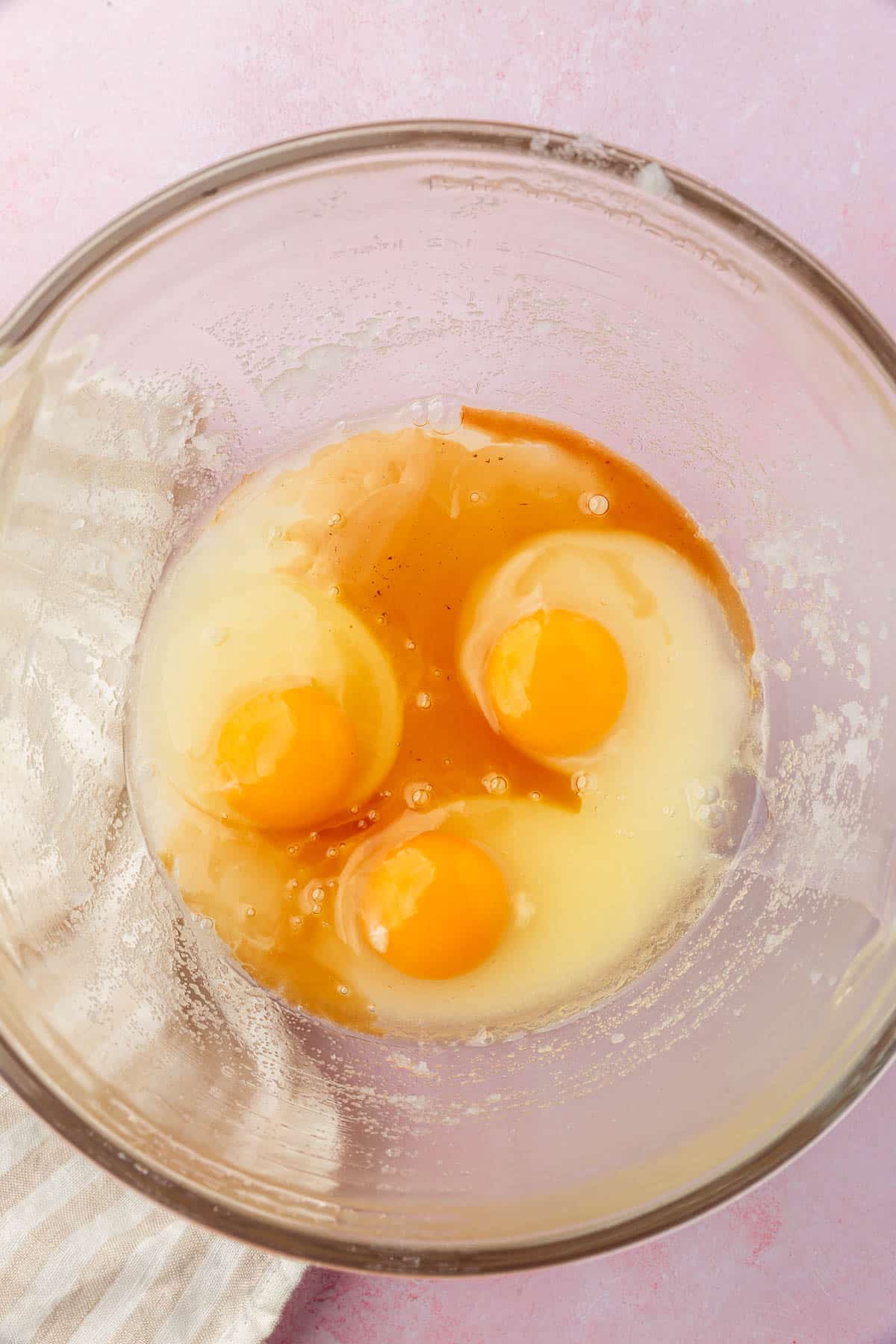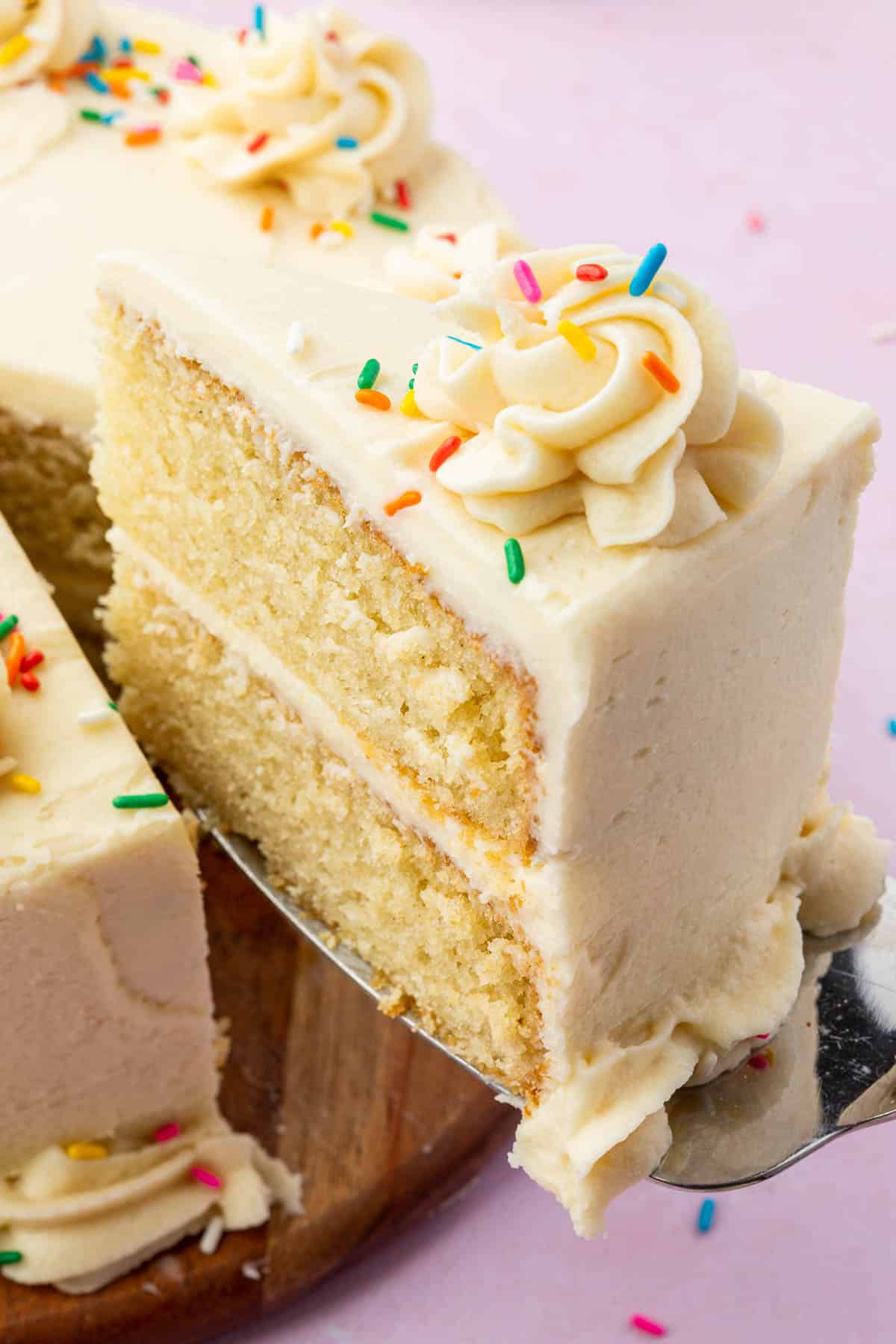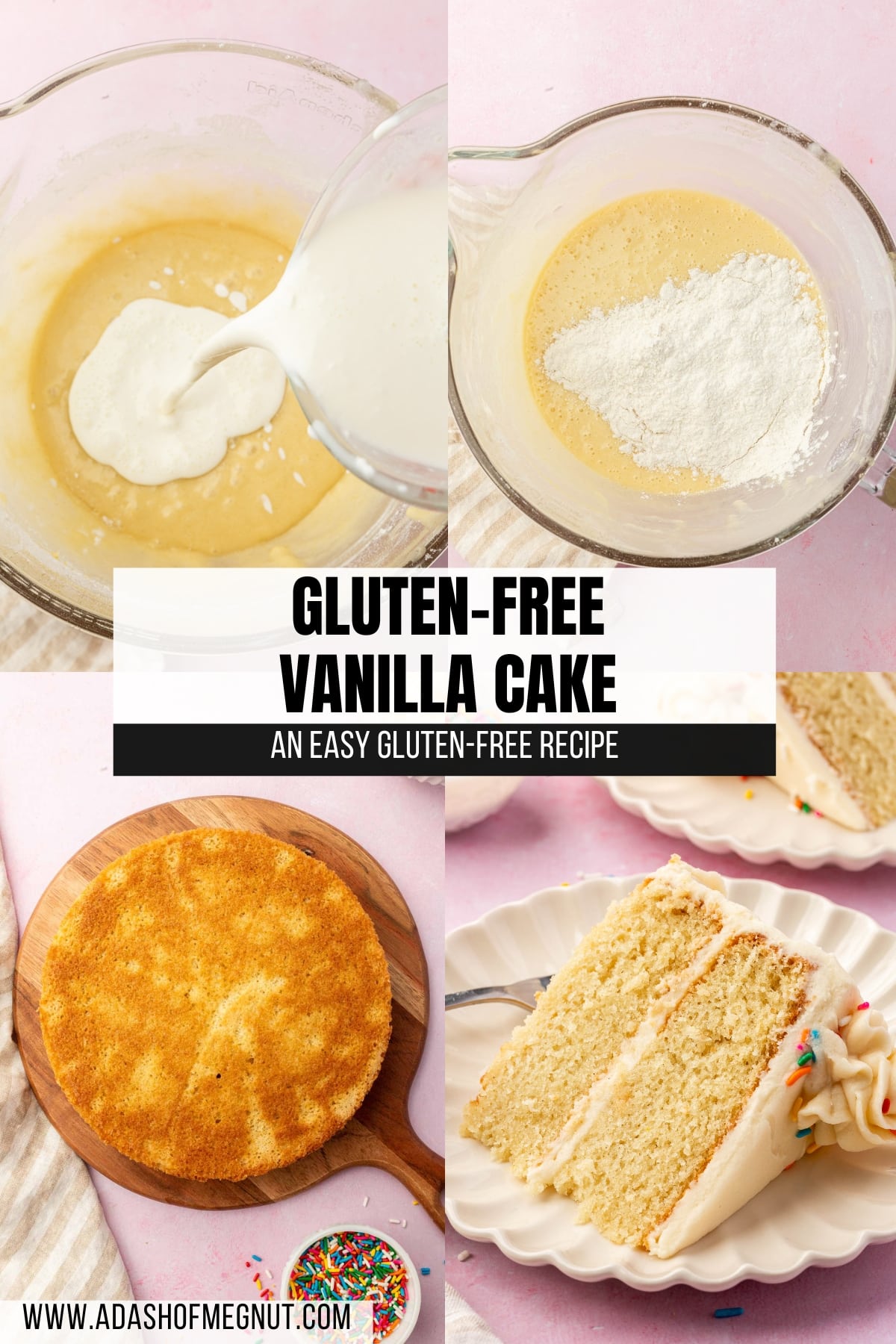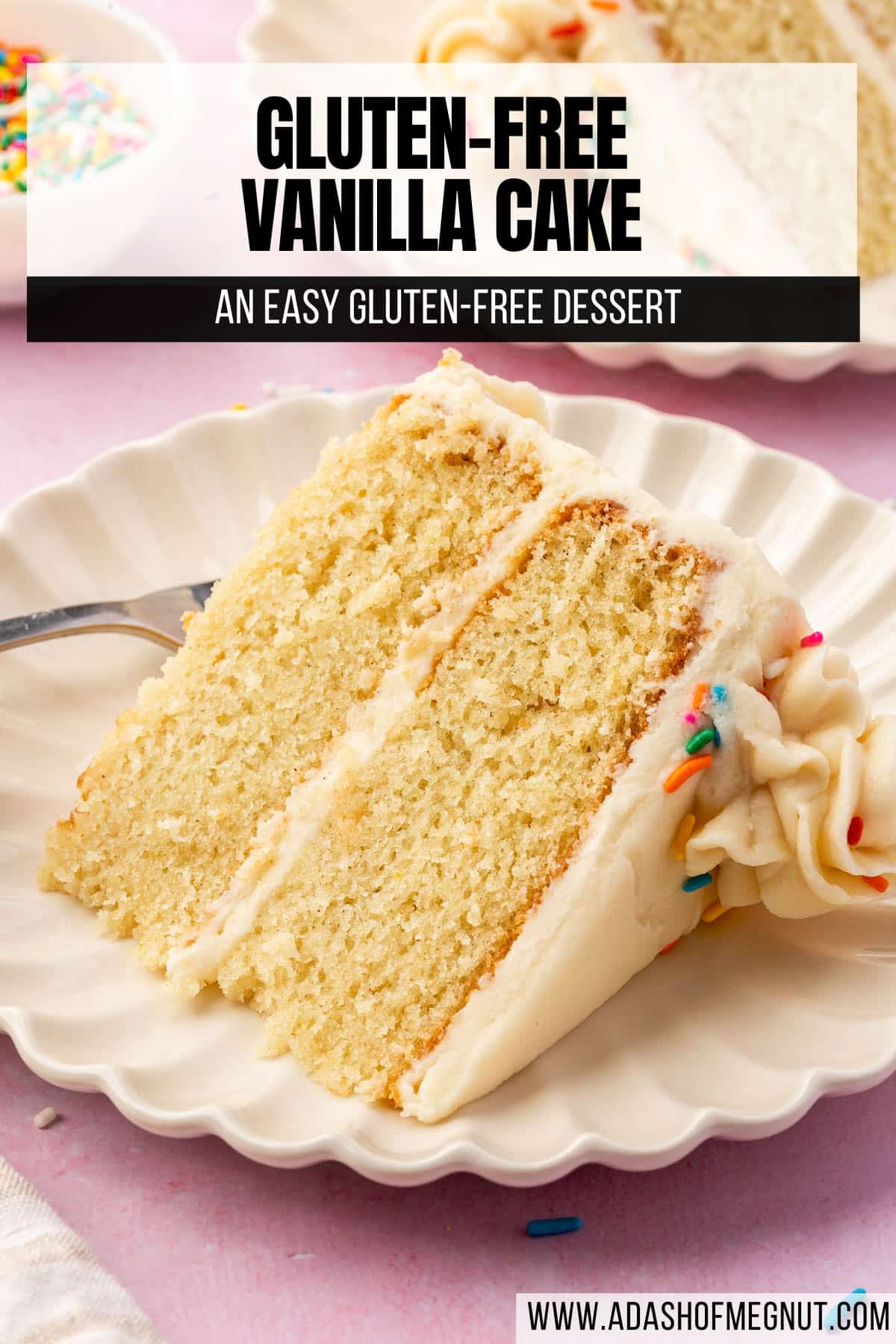
There is nothing more classic for a birthday than a vanilla cake. It never goes out of style! If you have celiac disease or are on a gluten-free diet, you might think vanilla cake is off the table for you. However, this recipe is the BEST gluten-free vanilla cake you’ll ever have. It’s moist, fluffy, and so tender.
Topped with an easy vanilla American buttercream, this cake is simple but big on vanilla flavor. Whether you’re celebrating a birthday, a holiday, or just treating yourself, this cake is sure to satisfy your sweet tooth.
Growing up, vanilla cake was always my favorite. I love the clean, classic flavor of vanilla. However, once I was diagnosed with celiac disease I found it hard to come by a great gluten-free vanilla cake. They always tended to be more dry than chocolate cakes.
After many years of testing, I finally have the perfect gluten-free cake recipe for you. It is everything that you want in a vanilla cake, without the gluten!
You’ll love this recipe because:
Ingredients

Ingredient Notes
- Gluten-free flour blend – I tested this recipe using Bob’s Red Mill 1-to-1 Gluten-Free Baking Flour. It is a gluten-free flour blend that is meant to be substituted for all-purpose flour in a 1-to-1 ratio. This flour already contains xanthan gum, so you will not need to add it to this recipe. I cannot guarantee that other gluten-free flours will work in this recipe because I have not tested them.
- Cornstarch – To make this gluten-free cake light and airy, I use cornstarch to essentially make a gluten-free cake flour. For best results, weigh the cornstarch to ensure you are adding the appropriate amount to the recipe.
- Baking powder – This is a leavening agent that helps the cake rise and become fluffy. Typically, you will need more baking powder in a gluten-free recipe than a traditional cake recipe because gluten-free varieties do not rise as much. Make sure to check the expiration date on your baking powder and use a fresh batch for best results.
- Baking soda – Some baking soda will give this cake additional rise.
- Granulated sugar – I do not recommend reducing the amount of granulated sugar in this recipe or replacing it with other sweeteners. Sugar does more than just sweetening the cake. It also adds moisture, structure, flavor, and browning to the cake. Reducing the amount of sugar will compromise the cake texture and flavor.
- Vegetable oil – Instead of butter, I’m using vegetable oil as the fat in my cake. I’ve found the problem with gluten-free vanilla cakes in the past is that they are too dry, so to ensure that my cake is as moist as possible I use vegetable oil instead of butter. Since vegetable oil is a liquid, it will produce a moister cake. The neutral flavor also lets the vanilla flavor shine through.
- Eggs – You need three large eggs for this recipe. I use large eggs that are 50g each when weighed outside of the shell. If you are using medium eggs, you’ll need more eggs for this recipe. Just mix the egg yolk and egg whites together and then weigh out 150g total before proceeding with the recipe.
- Vanilla extract – Since this is a vanilla cake, you’ll need vanilla extract to flavor it. Use pure vanilla extract (only vanilla and alcohol) instead of an imitation vanilla extract. The flavor will be much better this way. You can also use vanilla beans or vanilla paste if you prefer.
- Apple cider vinegar – This is one of my favorite ingredients for gluten-free baking. Gluten-free baked goods don’t rise as much as their gluten-filled counterparts so they need some additional help to leaven. I like to add a few teaspoons of apple cider vinegar, which is an acid, to help leaven my baked goods. You can’t taste the vinegar at all.
- Whole milk – For best results, use whole milk instead of skim milk in this recipe to give the cake more fat. This will help give you a tender crumb.
- Sour cream – Sour cream has a higher fat content than whole milk, so it adds additional richness to the cake. It also is acidic so it will react with the baking soda to leaven the cake.

The way that you measure flour will affect the outcome of your baking. For best results, use a food scale to weigh your ingredients. If you don’t have a food scale, make sure to spoon flour into the measuring cup and level it off with a knife for accurate measurement. Scooping the measuring cup directly into the bag of gluten-free flour will result in too much flour causing a dense vanilla cake.
Step-by-Step instructions
Paragraph saying how easy this is to make, just follow the steps and scroll down to the recipe card for more information, tips and tricks and the printable recipe.
For the ingredient list with measurements, full instructions, printable recipe, and additional notes, please scroll down to the recipe card.










Recipe FAQs
I tested this recipe with Bob’s Red Mill 1-to-1 Gluten-Free Baking Flour (in the blue bag). This blend already contains xanthan gum in it. I cannot verify that other gluten-free flours will work in this recipe.
I used 8-inch baking pans. I like to buy ones that are 2 or 3-inches high. If your baking pans are only 1-inch high, you’ll want to split the batter between 3 pans instead of two. The bake time will also decrease.
I love a simple vanilla frosting, but you can also try my chocolate cream cheese frosting, brown butter cream cheese frosting, strawberry frosting, or peanut butter frosting to change it up!
The cake is done when a toothpick inserted into the center of the cake comes out clean. You can also gently press on the top of the cake – it should feel springy and bounce back when touched.
hints & tips
Storage instructions
- Storage: A frosted vanilla cake will keep at room temperature in a container for 3-4 days. Make sure the container is sealed tightly to keep the cake fresh. If you are using a frosting that needs to be refrigerated, you can refrigerate the cake instead.
- Freezer Option: Cake freezes beautifully. I like to either freeze cake rounds that have not yet been frosted or frosted slices of cake. Wrap unfrosted cake rounds in plastic wrap and then place in an airtight container or freezer-safe bag and freeze for up to 3 months. Freeze individual slices on a baking sheet lined with parchment paper for an hour. Then individually wrap in plastic wrap or in freezer-safe containers for up to 3 months. Let thaw at room temperature until soft.

More gluten-free cakes to try
Did you make this recipe?
I’d love to know! Please rate it and leave a comment below. You can also share your pictures and tag @adashofmegnut on Instagram.

Gluten-Free Vanilla Cake
Ingredients
For the gluten-free vanilla cake:
- 2 1/2 cups gluten-free all purpose flour - 360g, I used Bob’s Red Mill 1-to-1 Gluten-Free Baking Flour Blend
- 1 tsp xanthan gum - omit if your blend already contains it
- 1/3 cup cornstarch - 43g
- 2 teaspoons baking powder
- 1 teaspoon baking soda
- 1 teaspoon salt
- 2 cups granulated sugar - 400g
- 3/4 cup vegetable oil - 170g
- 3 large eggs - 150g
- 2 teaspoons vanilla extract
- 2 teaspoons apple cider vinegar
- 3/4 cup whole milk - 180g
- 3/4 cup sour cream - 180g
For the vanilla frosting:
- 1 cup unsalted butter - softened (226g)
- 2 teaspoons vanilla extract
- 1/4 teaspoon salt
- 4 cups powdered sugar - 480g
- 2-4 tablespoons whole milk
**Use the toggle button above to turn the instruction photos on and off!
Instructions
For the gluten-free vanilla cake:
- Preheat the oven to 350F. Line with parchment paper and grease two 8-inch round cake pans with butter and dust with gluten-free flour. Set aside.
- In a medium bowl, add the gluten-free flour, cornstarch, baking powder, baking soda, and salt. Whisk until combined. Set aside.
- In a large bowl, add the granulated sugar and vegetable oil. Beat with an electric mixer for a few minutes, until combined.
- Add the eggs, vanilla extract and apple cider vinegar. Mix until smooth.
- Add 1/3 of the dry ingredients to the cake batter. Mix until combined.
- Combine the sour cream and milk in a measuring cup or bowl. Add 1/2 of this sour cream mixture to the cake batter. Mix until combined.
- Repeat with 1/3 of the dry ingredients, the remaining 1/2 of the sour cream mixture, and finish with the last 1/3 of the dry ingredients, mixing in between each addition.
- Pour the vanilla cake batter into the prepared cake pans.
- Bake at 350F for 35-40 minutes, until a toothpick inserted into the center comes out clean.
- Let the cake cool for 10 minutes before inverting from the pans onto a wire cooling rack to finish cooling.
- Cool completely before frosting and serving.
For the frosting:
- Add the softened butter to a large mixing bowl. Using an electric mixer, beat the butter until smooth.
- Add the vanilla extract and salt and mix until combined.
- Gradually add in the powdered sugar, about ½ cup at a time, mixing in between. Be sure to scrape down the sides and bottom of the bowl to ensure it is all mixed in.
- Add two tablespoons of milk and mix until it is a pipeable consistency. You don’t want the buttercream frosting to be too stiff because it will be difficult to spread on the cake, but also not too loose that it will slide around on the cake. Add more milk if needed.
- Frost the cake as desired.
Notes
- For best results, use a food scale to weigh the dry ingredients in grams, including gluten-free flour and cornstarch. This is the most precise method of measuring ingredients and will prevent the cake from becoming too dense. I’ve included the metric measurements in the recipe card.
- If you have celiac disease or require a gluten-free diet, always confirm that all ingredients are gluten-free. Ingredient formulations and manufacturing processes can change from time to time.
- Make sure the cake has completely cooled before decorating with frosting to prevent the frosting from melting on the warm cake.
- Store any leftover cake in an airtight container at room temperature for up to 3-4 days. Alternatively, you may freeze the vanilla cake for longer storage.









Oh my goodness. I know what I want my next birthday cake to be like!!! This is AMAZING!
Oh my gosh that is beautiful!
gorgeous! i wish you would make me a 25th birthday cake! 🙂
I have a gluten free flour that includes cornstarch, but yet your recipe asks for it as well. I included the cornstarch, is this ok? The baking of the cake looks a bit odd?
Hi Nicole,
Which gluten-free flour did you use? As my blog post states, I can only recommend Bob’s Red Mill 1-to-1 Gluten-Free Baking Flour (in the blue bag), so if you didn’t use that flour, that would be why it looks odd. Yes, you need the cornstarch as well. We are basically making a gluten-free cake flour blend by combining that flour and the cornstarch. Can you let me know which flour you used so we can figure out what happened here? I appreciate the review, but giving 3 stars is not helpful for other readers if you did not use the flour blend I used.
Thanks!
Megan